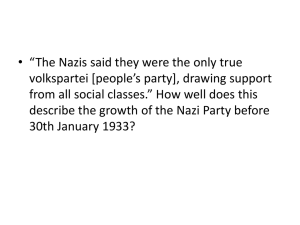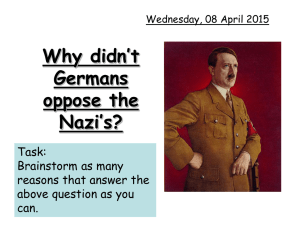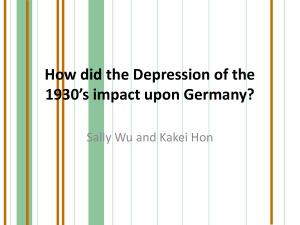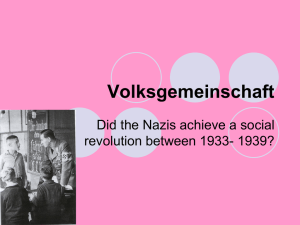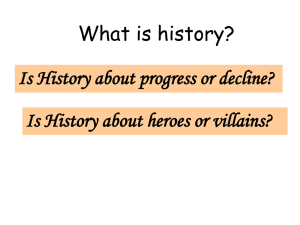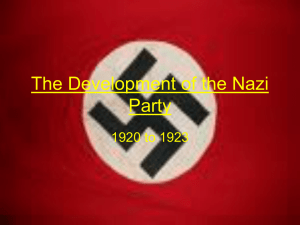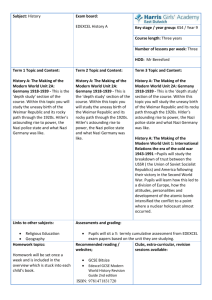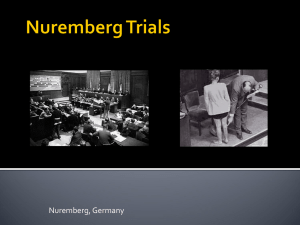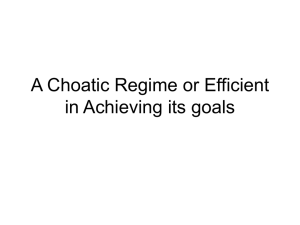Who Voted Nazi?
advertisement
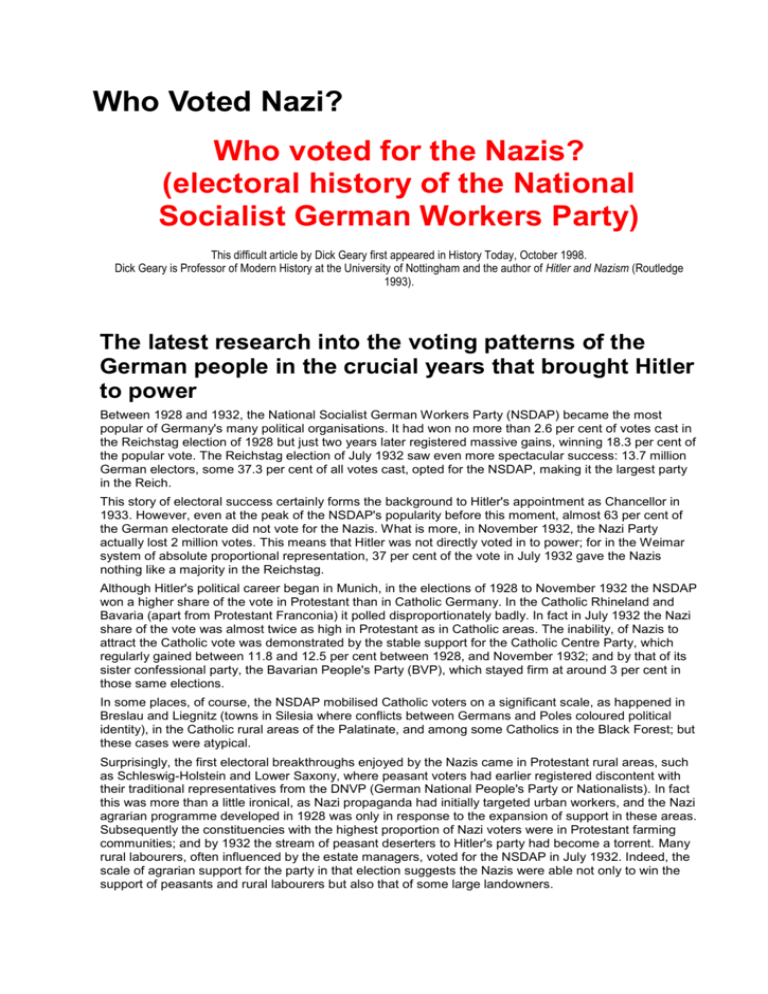
Who Voted Nazi? Who voted for the Nazis? (electoral history of the National Socialist German Workers Party) This difficult article by Dick Geary first appeared in History Today, October 1998. Dick Geary is Professor of Modern History at the University of Nottingham and the author of Hitler and Nazism (Routledge 1993). The latest research into the voting patterns of the German people in the crucial years that brought Hitler to power Between 1928 and 1932, the National Socialist German Workers Party (NSDAP) became the most popular of Germany's many political organisations. It had won no more than 2.6 per cent of votes cast in the Reichstag election of 1928 but just two years later registered massive gains, winning 18.3 per cent of the popular vote. The Reichstag election of July 1932 saw even more spectacular success: 13.7 million German electors, some 37.3 per cent of all votes cast, opted for the NSDAP, making it the largest party in the Reich. This story of electoral success certainly forms the background to Hitler's appointment as Chancellor in 1933. However, even at the peak of the NSDAP's popularity before this moment, almost 63 per cent of the German electorate did not vote for the Nazis. What is more, in November 1932, the Nazi Party actually lost 2 million votes. This means that Hitler was not directly voted in to power; for in the Weimar system of absolute proportional representation, 37 per cent of the vote in July 1932 gave the Nazis nothing like a majority in the Reichstag. Although Hitler's political career began in Munich, in the elections of 1928 to November 1932 the NSDAP won a higher share of the vote in Protestant than in Catholic Germany. In the Catholic Rhineland and Bavaria (apart from Protestant Franconia) it polled disproportionately badly. In fact in July 1932 the Nazi share of the vote was almost twice as high in Protestant as in Catholic areas. The inability, of Nazis to attract the Catholic vote was demonstrated by the stable support for the Catholic Centre Party, which regularly gained between 11.8 and 12.5 per cent between 1928, and November 1932; and by that of its sister confessional party, the Bavarian People's Party (BVP), which stayed firm at around 3 per cent in those same elections. In some places, of course, the NSDAP mobilised Catholic voters on a significant scale, as happened in Breslau and Liegnitz (towns in Silesia where conflicts between Germans and Poles coloured political identity), in the Catholic rural areas of the Palatinate, and among some Catholics in the Black Forest; but these cases were atypical. Surprisingly, the first electoral breakthroughs enjoyed by the Nazis came in Protestant rural areas, such as Schleswig-Holstein and Lower Saxony, where peasant voters had earlier registered discontent with their traditional representatives from the DNVP (German National People's Party or Nationalists). In fact this was more than a little ironical, as Nazi propaganda had initially targeted urban workers, and the Nazi agrarian programme developed in 1928 was only in response to the expansion of support in these areas. Subsequently the constituencies with the highest proportion of Nazi voters were in Protestant farming communities; and by 1932 the stream of peasant deserters to Hitler's party had become a torrent. Many rural labourers, often influenced by the estate managers, voted for the NSDAP in July 1932. Indeed, the scale of agrarian support for the party in that election suggests the Nazis were able not only to win the support of peasants and rural labourers but also that of some large landowners. Voters in large urban centres were less susceptible to Nazi electoral propaganda. In July 1932, the NSDAP's support in the Grosstadte (over 100,000 inhabitants) was 10 per cent lower than the national average. Though there had been a significant increase in support among German workers between 1930 and 1932, this was less marked in the larger cities; and nearly half the working-class newcomers to the party ranks between 1925 and 1932 came from villages of under 5,000 inhabitants. And proportionally few of the working-class storm-troopers of the SA came from the big cities. In part this pattern reflects the point that Hitler and his followers were able to build support in small provincial towns and rural areas more effectively than in the large cities precisely because political mobilisation was less developed in the provinces and the countryside. SPD (Social Democrat) and KPD (Communist) support had been and was still concentrated in the big cities, and the electoral drive of the NSDAP encountered powerful traditions and loyalties there. This urban/rural divide was reinforced by another factor: the Nazis were relatively unsuccessful in gaining the electoral support of the unemployed, who were also concentrated in Germany's largest cities. For many years the Nazi movement was seen as a political response of the German Mittelstand (lower middle class) of small businessmen, independent artisans, small shopkeepers and the self-employed, to the threats coming from big business and large retail stores, from the trade unions, the SPD and the KPD, and from increased government interference and taxes to pay for Weimar's burgeoning welfare state. In many respects it was such a response -- in its combination of anti-socialist and anti-big business rhetoric, and in its social support. The lower middle class of Germany's Protestant towns did constitute the hard-core of Nazi support and were over-represented in the membership of the NSDAP. If there is little dispute about the politics of Germany's so-called old Mittelstand, there is rather more about the political identity of the new Mittelstand (white-collar workers). It was once thought that this group (roughly 20 per cent of the German labour force) shared the status anxieties of its older counterpart and their Nazi politics; but there is only limited evidence to support this contention and the voting behaviour of white-collar workers was tar from uniform, with civil servants more likely to register higher levels of support for Hitler than their counterparts within the private sector. There were divisions even within that sector, as sales assistants and supervisory, rather than technical staff were more likely to vote Nazi, while white-collar workers from manual backgrounds and those who lived in the workingclass districts of large cities often gave their votes to the SPD. The National Socialists also won the backing of significant numbers of Protestants from both the upper middle class and the manual working class. There is considerable evidence, for example, of Nazi voting on the part of Protestants living in some of the wealthiest districts of Hamburg and Berlin. This, together with the voting returns from upper-class holiday resorts and even cruise liners, indicates that sections of the upper middle class also voted for Hitler at the height of the economic and political crisis of 1932; such support had been withheld earlier, and party membership among this group still remained a rarity. Considerable attention has been devoted to the appeal of Nazism to many in the professions such as doctors and engineers, as well as civil servants, leading some to claim that anti-modernism provides the key to Hitler's triumph. A vast literature has also been devoted to the relationship between the Nazis and big business. It is fairly clear that big business was less likely to support the NSDAP than small business; that the party allegiances of individual industrialists varied; and that Fritz Thyssen's membership of and donations to the Nazi Party were a typical of the business community as a whole. The Nazi Party was largely self-financing, and industrial money was most likely to find its way into the coffers of the DNVP and DVP, though some concerns (such as Flick) did spread their donations over virtually all bourgeois parties, including the NSDAP, as a kind of political insurance. Of course, industry was not hostile to welfare taxation and the power of the unions, which it saw as the essence of Weimar; and by 1932 many industrialists wanted to be rid of the Republic. Most, however, would have preferred a solution that excluded the Nazis. More contentious has been the relationship between workers and the Nazi Party. Recent research has revised the impression of working-class immunity to Nazism: around 55 per cent of SA stormtroopers came from working-class backgrounds and the Nazis made substantial gains from working-class communities in parts of Saxony, especially around Chemnitz. Around 40 per cent of members of the Party seem to have been of working-class origins; similarly 40 per cent of the Nazi vote came from workers and one worker in every four voted for Hitler in July 1932. There is little correlation between the percentage of workers in a community and the level of support for the NSDAP, though there is a slight positive correlation between the percentage of employed workers and the size of the Nazi vote. In 1930 some 3 per cent of Nazi votes came from former KPD and 14 per cent from former SPD voters (July 1932, 2 per cent and 10 per cent respectively); and the number of workers voting for the National Socialists in the first Reichstag elections of 1932 was greater than the number of workers voting for the SPD or the KPD individually (though not than the number voting for SPD and KPD combined). There can be no doubt that the NSDAP recruited across a broad social spectrum. However, its support was not random. We have already noted the over-representation of Protestants, rural areas and small provincial towns, as well as of the Mittelstand, in Nazi support and there was a similar structure to the movement's working-class constituency. The working class, however, was under-represented in the Nazi ranks when compared to the German population as a whole. The working-class presence among those who voted for Hitler can be made to correlate positively with the proportion of working classes in the electorate as a whole only when foremen, daily helps, workers in domestic industry and, significantly, agricultural labourers are included in the definition of working class. When rural labourers (who inhabited a world quite different to that of the city dweller and factory employee, often paid in kind or subject to landlord pressure) are removed from the equation, a slight negative correlation arises between Nazi support and working-class presence. And if workers in craft (as distinct from factory) sectors are also removed from the equation, the correlation becomes even more negative. It is negative, too, in the large cities where, the closer we look at the factory working class, the lower the percentage support for the NSDAP becomes. Furthermore, only 13 per cent of the unemployed -- who comprised some 30 per cent of the manual working class in the middle of 1932 and who were over whelmingly concentrated in the big cities and in large-scale manufacture -- supported the National Socialists. It therefore is clear that, although large numbers of workers did vote Nazi, these were not in the main from the classic socialist or communist milieux, rooted as these were in the large cities and in employees in the secondary sector of the economy. If the number of workers in this sector plus the unemployed is correlated with electoral support for the NSDAP, the result is clearly even more negative. This helps to explain why the rise in the Nazi vote made only a relatively small dent in the size of support of the SPD and KPD vote taken together. It is not unreasonable to look at the combined SPD and KPD vote; for, although there was some defection of former SPD voters to the Nazis, there was little desertion from the KPD. Most local studies of the labour vote further suggest that most defections from the SPD benefited the Communists rather than the Nazis. The significance of the socialist milieu in combatting Nazi incursions is evident in recent work on Saxony. The Nazis made gains amongst Saxon workers where the social-democratic milieu was weak or had collapsed in the Depression. Conversely the Social Democrats in Dresden and, especially, Leipzig were successful in defending their position against National Socialist incursions, because a high percentage of SPD voters in these towns were also members of the party and there existed a dense network of socialdemocratic leisure and cultural organisations. Where the percentage of socialist party members to SPD voters and the density of party organisations was lower, as in Chemnitz and especially Zwickau, the Nazis were much more successful in making inroads into the working-class electorate. In the Erzgebirge and the Vogtland the SPD almost disintegrated completely for the same reasons. This does not mean the Nazis gained no votes or members from big-city workers; nor is it to deny that most working-class occupations found some representation in Nazi organisations. To find miners and metalworkers in NSDAP organisations in the Ruhr, for example, is scarcely surprising, given the extent to which these occupational groups dominated the district. However, not all miners inhabited the same daily world. Miners in the rural districts around Bochum, for example, were more likely to vote for the NSDAP than those who lived in the mining colonies of redundant pits in Bochum and Herne, where the Nazis often captured under 15 per cent of the vote in July 1932 and where the Communists were dominant. It is clear that some groups of workers were much more prone to support the NSDAP than others. This applies above all to rural labourers, to workers in rural areas and small provincial towns, and to craft workers in small units of production. Also to former agricultural workers; workers for whom industrial employment was only an ancillary activity; commuters who lived in the countryside but worked in town; workers in domestic industry, (often non-unionised, without socialist traditions and often female); and workers in transport, the postal services and the utilities (gas, water, electricity). In the latter cases both the KPD and the NSDAP benefited from the fact that it was often social-democratic local government which had to restrict the wages of their employees or lay them off in the Depression. Many of these Nazi workers were skilled. Yet workers' organisations in this period invariably recruited their members from skilled rather than unskilled workers. Also the fact that some fitters and mechanics voted Nazi does not mean that the), were the same kind of metalworkers as those who -- in very large numbers -- found themselves in the SPD and especially the KPD. For example, mechanics and fitters in garages, repair shops and the like bear more resemblance to those in small-scale craft production than their colleagues in the engineering plants of Berlin or Stuttgart. Many metalworkers were Nazi members; but the significance of this would be clearer if we knew more about the location and nature of their work. Other kinds of workers attracted to Nazism included Germany's equivalent of `working-class Tories': workers with a tradition of support for non-socialist politics, who had voted National Liberals under the Empire and DNVP in the early years of Weimar, but turned to the NSDAP in the Depression. Such were those employees of Krupp in Essen, who lived in company housing and benefited from an old tradition of employer paternalism. The NSDAP also made gains among those recruited from Stahlhelm labour exchanges in the Ruhr, and among workers recruited by textile employees in Franconia in 1932 precisely on account of their anti-socialist credentials. Thus a combination of variables produced the working-class Nazi. The NSDAP was very different to the parties of the Left, which were dominated by factory workers in the large towns, did not possess substantial middle-class support; and were less attractive to females but much more attractive to the unemployed than the NSDAP. It has often been assumed that the rise of Nazism was inextricably intertwined with unemployment. As unemployment rose dramatically after 1928, peaked in the spring of 1932 and then declined, so did the National Socialist vote. However, Nazi party members were usually in employment; and unemployment was concentrated in those places where the Nazi vote was relatively low, such as Germany's large cities. There was a negative correlation between unemployment and NSDAP electoral support, for example in the towns of Bochum and Herne (another mining centre), and the Nazis polled worst in the pit colonies with very high levels of unemployment, where the Communists benefited from the votes of the jobless. Only 13 per cent of the unemployed supported the NSDAP, and those without jobs were over twice as likely to support the KPD. In short, the Nazi party clearly won a large number of workers' votes at the peak of its popularity in July 1932, but the social profile of its electorate was markedly different from that of the specifically workers' parties, whose support came disproportionately from manual workers. A further difference resides in the gender of support. The NSDAP, at least in the Depression of the early 1930s, was much more attractive to female voters than the German Left in general, and the KPD in particular. For most of the Weimar Republic women voted less frequently than men, especially in rural areas. When they did vote, wives often followed their husbands; and daughters and sisters, the head of the household; or so many have claimed. It is also not unreasonable to believe that the female vote divided along the same lines of class, confession and region as that of men. Yet there existed significant differences between male and female voting patterns. Women were less likely to vote for left-wing parties than their menfolk, though there was an increase in the percentage of female votes that went to the SPD in the 1920s. In fact around 3.5 million women cast their votes for Social Democracy by 1930; and far fewer female than male SPD voters deserted to the Communists in the Depression. In the Berlin Reichstag election of 1930, 27.1 per cent of male and 28.8 per cent of female votes went to the Social Democrats; but in the case of the KPD the gender difference was more marked, with the party picking up 37 per cent of the male but only 29.8 per cent of the female vote. In the Cologne-Aachen district in 1930, 20 per cent of male and 17.2 per cent of female voters gave their support to the SPD; but for the KPD the voting percentages were 21.4 and 13.4 respectively. The relative unattractiveness of the Left to female voters was compensated by a propensity to support those parties close to the churches, such as the nationalist DNVP in the case of Protestants and, to a much greater extent, the Centre Party or BVP in the case of Catholics. In Cologne-Aachen in 1930, 18.9 per cent of male and 33.1 per cent of females voted for the Centre Party. In Augsburg in the same year, 24.8 per cent of men and 39 per cent of women gave their support to the BVP. Desertions from the Catholic camp to the KPD and the NSDAP in the Depression were almost exclusively male. Until 1930 women remained unlikely to vote for the Nazi Party. Moreover, in the presidential election of 1932 a clear majority of women preferred Hindenburg to Hitler. However, the early 1930s did see a narrowing of the gap between male and female voting patterns, especially in Protestant areas. Indeed, in some of these by July 1932 the NSDAP was winning a higher percentage of the female to male vote. In that month some 6.5 million women voted Nazi, many of them probably with few or no previous political ties. Where they came from the working class, they were likely to be non-unionised textile operatives or domestic workers. Electoral support for the NSDAP was spread across the age range. The Nazi Party has often been portrayed as a dynamic inspirer of youth and contrasted with the sclerosis of the traditional Right. This youthful image of the NSDAP (and more rightly of the SA) certainly has some foundation. NSDAP membership was younger than that of other parties; the average age of those joining between 1925 and 1932 was slightly under twenty-nine. It rose slightly, to an average of thirty-two in 1932. That the Nazis did well with new voters may reflect their youthfulness. This, however, is only part of the story. Firstly, youth support for the NSDAP cannot be divorced from issues of class and confession. Of the new members, 47 per cent were workers (under-representing them as a percentage of the population as a whole), whereas white-collar employees at 20 per cent were overrepresented and the old middle class of the self-employed at 27 per cent more so. Secondly, the KPD was also successful in mobilising the support of a significant section of German youth, though this support was much more clearly located among the unemployed and manual workers of the large towns than was that of the Nazi Party. Thirdly, the NSDAP was arguably most successful of all in picking up the votes of pensioners and the elderly. This group, especially the women, constituted the largest reservoir of previous non-voters in the early 1930s, and the party made a specific bid for the support of pensioners, the elderly and war veterans who had seen the value of their pensions and savings eroded. Here again the Nazis enjoyed success with those lacking previously strong political or ideological ties. As the rate of electoral participation increased (from 74.6 per cent in 1928 to 83.4 per cent in July 1932), so the NSDAP picked up the new votes not only of the young and newly enfranchised, but also of this geriatric electorate. The Nazi Party was therefore without doubt a Volkspartei: recruiting its members and its voters across a broad range of social groups, from both sexes and from the older as well as the younger generation. However, this support was never able to deliver enough votes for a parliamentary majority, nor was it distributed randomly across German society. Being a Catholic, unemployed or living in a large town significantly reduced the likelihood of voters to opt for Hitler, as did the existence of strong ideological and political traditions. Conversely, being a Protestant in rural Germany greatly increased such a propensity, as did the absence of strong loyalties. The structure of Nazi support therefore requires that explanations of the rise of Hitler are not simply reduced to the experiences and sentiments common to all Germans, but must take into account both the timing of Nazi success and the specific grievances of those who did choose the NSDAP to speak for them. FOR FURTHER READING Thomas Childers, The Nazi Voter (University of North Carolina Press, 1983) and (ed) The Formation of the Nazi Constituency (University of North Carolina Press, 1986); Conan Fischer (ed) The Rise of Nazism and the Working Classes in Weimar Germany (OUP, 1996); Richard Hamilton, Who Voted For Hitler? (Princeton University Press, 1983); Michael Kater, The Nazi Party (Blackwell, 1983); Helen Boak, `Women in Weimar Germany: The "Frauenfrage" and the Female Vote' in Richard Bessel and E.J. Feuchtwanger (eds), Social Change and Political Development in the Weimar Republic (Croom Helm, 1981).
